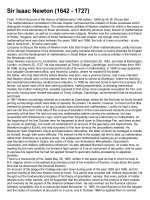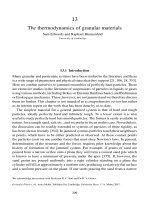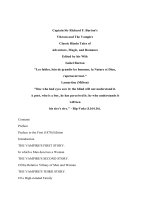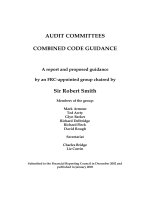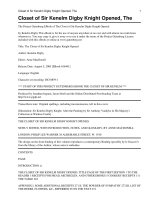Sir mcmc
Bạn đang xem bản rút gọn của tài liệu. Xem và tải ngay bản đầy đủ của tài liệu tại đây (229.22 KB, 4 trang )
Simple MCMC under SIR
Lam ST Ho and Marc A Suchard
2016-12-05
We describe how to set-up and run a simple Metropolis-Hastings-based Markov chain Monte Carlo (MCMC)
sampler under the susceptible-infected-removed (SIR) model.
library(MultiBD)
This example uses the Eyam data that consist the population counts of susceptible, infected and removed
individuals across several time points.
data(Eyam)
Eyam
##
##
##
##
##
##
##
##
##
1
2
3
4
5
6
7
8
time
0.0
0.5
1.0
1.5
2.0
2.5
3.0
4.0
S
254
235
201
153
121
110
97
83
I
7
14
22
29
20
8
8
0
R
0
12
38
79
120
143
156
178
The log likelihood function is the sum of the log of the transition probabilities between two consecutive
observations. Note that, we will use (log α, log β) as parameters instead of (α, β). The rows and columns of
the transition probability matrix returned by dbd_prob() correspond to possible values of S (from a to a0)
and I (from 0 to B) respectively.
loglik_sir <- function(param, data) {
alpha <- exp(param[1]) # Rates must be non-negative
beta <- exp(param[2])
# Set-up SIR model
drates1 <- function(a,
brates2 <- function(a,
drates2 <- function(a,
trans12 <- function(a,
}
b)
b)
b)
b)
{
{
{
{
0 }
0 }
alpha * b
}
beta * a * b }
sum(sapply(1:(nrow(data) - 1), # Sum across all time steps k
function(k) {
log(
dbd_prob( # Compute the transition probability matrix
t = data$time[k + 1] - data$time[k], # Time increment
a0 = data$S[k], b0 = data$I[k],
# From: S(t_k), I(t_k)
drates1, brates2, drates2, trans12,
a = data$S[k + 1], B = data$S[k] + data$I[k] - data$S[k + 1],
computeMode = 4, nblocks = 80
# Compute using 4 threads
)[1, data$I[k + 1] + 1]
# To: S(t_(k+1)), I(t_(k+1))
)
}))
1
Here, we choose Normal(0, 1002 ) as the prior for both log α and log β.
logprior <- function(param) {
log_alpha <- param[1]
log_beta <- param[2]
}
dnorm(log_alpha, mean = 0, sd = 100, log = TRUE) +
dnorm(log_beta, mean = 0, sd = 100, log = TRUE)
We will use the random walk Metropolis algorithm implemented in the function MCMCmetrop1R()
(MCMCpack package) to explore the posterior distribution. So, we first need to install the package and its
dependencies.
source(" />biocLite("graph")
biocLite("Rgraphviz")
install.packages("MCMCpack", repos = '')
library(MCMCpack)
The starting point of our Markov chain is the estimated value of (α, β) from Raggett (1982).
alpha0 <- 3.39
beta0 <- 0.0212
We discard the first 200 iterations and keep the next 1000 iterations of the chain.
post_sample <- MCMCmetrop1R(fun = function(param) { loglik_sir(param, Eyam) + logprior(param) },
theta.init = log(c(alpha0, beta0)),
mcmc = 1000, burnin = 200)
The trace plots of both log α and log β look good.
1.1
0.9
1.0
log(α)
1.2
1.3
plot(as.vector(post_sample[,1]), type = "l", xlab = "Iteration", ylab = expression(log(alpha)))
0
200
400
600
800
1000
Iteration
plot(as.vector(post_sample[,2]), type = "l", xlab = "Iteration", ylab = expression(log(beta)))
2
−3.8
−4.0
−4.2
log(β)
0
200
400
600
800
1000
Iteration
We can visualize the joint posterior distribution of log α and log β using the ggplot2 package.
library(ggplot2)
x = as.vector(post_sample[,1])
y = as.vector(post_sample[,2])
df <- data.frame(x, y)
ggplot(df,aes(x = x,y = y)) +
stat_density2d(aes(fill = ..level..), geom = "polygon", h = 0.26) +
scale_fill_gradient(low = "grey85", high = "grey35", guide = FALSE) +
xlab(expression(log(alpha))) +
ylab(expression(log(beta)))
3
−3.7
log(β)
−3.8
−3.9
−4.0
−4.1
1.0
1.1
log(α)
1.2
We can also construct the 95% Bayesian credible intervals for α and β.
quantile(exp(post_sample[,1]), probs = c(0.025,0.975))
##
2.5%
97.5%
## 2.721921 3.809780
quantile(exp(post_sample[,2]), probs = c(0.025,0.975))
##
2.5%
97.5%
## 0.01649866 0.02327176
4
1.3
